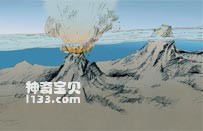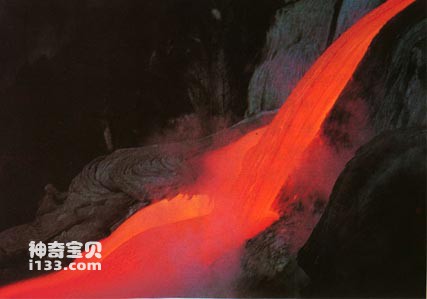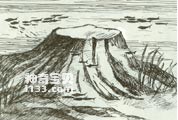On November 15, 1963, 32 kilometers south of Iceland in the North Atlantic, a submarine volcano 130 meters below the sea suddenly erupted, ejecting volcanic ash and water vapor columns hundreds of meters high. At the climax of the eruption, the volcanic ash and smoke were washed up to several kilometers. Thousands of meters in the air.

Undersea volcanic eruption

The lava flowing from Hawaiian volcanoes is spectacular
After one day and one night, on November 16, people suddenly discovered that a small island grew out of the sea. People visually measured the size of the island, which was about 40 meters high and 550 meters long. The waves on the sea surface could not tolerate the newly emerged islands, and washed away many volcanic ash and porous foam stones accumulated near the islands. People were worried that the young islands would be swallowed up by the waves. But the volcano kept erupting, lava gushes out like a gush, and the island not only did not disappear, but continued to expand and grow taller. After a year, by the end of November 1964, the newly born volcanic island had grown to an altitude of 170 meters high and 1700 meters long, this is the island of Surtesee. After being baptized by waves and nature, the island has withstood severe tests and stands tall on the vast ocean. Some small trees and grass actually grow on the island.

Hess was thinking: Why is the top of the mountain so flat?
Two years later, on August 19, 1966, the volcano erupted again. Water vapor columns and lava rushed out along the crater, hundreds of meters high. The eruption continued intermittently until May 5, 1967, when it came to an end. During this period, the island also took the opportunity to develop and grow, rapidly increasing its area by 0.4 hectares every day and night, and the volcano spewed approximately 180,000 tons of lava per hour.
Undersea volcanoes are widely distributed, and the many conical mountains scattered on the ocean floor are their masterpieces. The mountains left after volcanic eruptions are all cone-shaped. According to statistics, there are more than 20,000 submarine volcanoes in the world, and the Pacific Ocean has more than half of them. Some of these volcanoes have aged and died, some are in their young and active period, and some are dormant. It is uncertain when they will wake up and "come back". Except for a few scattered in the ocean basins, most of the existing active volcanoes are distributed in a belt on the fault zones of island arcs and central ridges, collectively called submarine volcanic belts. Earthquakes and volcanoes around the Pacific release about 80% of the world's energy. Undersea volcanoes, whether dead or alive, are collectively called seamounts. Seamounts vary in size, with the largest number being small seamounts one to two kilometers high. There are far fewer seamounts over 5 kilometers high, and there are only a handful of seamounts (islands) that are exposed to the sea. The Hawaiian Island in the United States is the result of submarine volcanoes. It covers an area of more than 10,000 square kilometers and has more than 100,000 residents. It has a humid climate, dense forests, fertile land, rich in sugar cane and coffee, beautiful mountains and clear waters, and a good port and airport. It is a tourist attraction. There are still five shield volcanoes left on Hawaii Island. Among them, Mauna Loa volcano is 4,170 meters above sea level. Its large caldera is 5,000 meters in diameter, and red lava often flows out. It had a large-scale eruption in 1950 and is a famous active volcano in the world.

Experts have different opinions on why some mountain tops on the seabed are flat.

Undersea flat-top mountain
Seamounts have domes and flat tops. The top of Pingding Mountain seems to have been cut off by some force. In the past, people didn't know that there were such flat-topped mountains on the seabed. During World War II, in order to adapt to the requirements of naval warfare, it was necessary to understand the situation on the seabed to facilitate the activities of warships and submarines. American scientist Professor H. H. Hess of Plimpton University was serving as the captain of the "Johnson" at the time, and accepted orders from the U.S. military to investigate the conditions on the Pacific Ocean floor. He led the officers and soldiers on the ship to conduct a comprehensive survey of the Pacific Ocean bottom using echo sounders, and discovered a large number of seamounts. They were either isolated peaks or groups of peaks, most of which were arranged in a row. This was formed by volcanic lava that erupted from the cracks in the rift valley. This is the first time humans have discovered an undersea mesa. This peculiar flat-topped mountain ranges in height and height, mostly below 200 meters, and some are even 2,000 meters deep. Hess called any flat-topped mountain with a water depth less than 200 meters a "beach". In 1946, Hess officially named the flat-topped mountain located more than 200 meters deep as "Guillot".

The flat-topped mountains move sideways away from the ocean ridge and sink vertically.
After Hess discovered the flat-topped mountain on the seabed, he was very puzzled at the time. He thought hard: Why is the top of the mountain so flat? Where have the round hills gone? Later, after painstaking research by scientists, the mystery was finally solved. It turns out that the mountain tops formed after the eruption of submarine volcanoes were indeed complete at that time. If the tops of seamounts are much higher than the sea surface, no matter how the waves crash and wash them, they will not be able to shake them, because the seamounts have established a firm footing and turned into real islands. Hawaii Island is one example. If the submarine volcano is relatively small from the beginning and is far below the sea surface, the power of the waves cannot reach it, and the top of the mountain will be safe. There are only those that are neither high nor short, with the top of the mountain slightly higher than the sea surface. The waves make them unstable and beat and wash them desperately. After years of hard work, the mountain tops are flattened and become flat-topped mountains that are slightly lower than the sea surface and have a flat top.
animal tags:
We created this article in conjunction with AI technology, then made sure it was fact-checked and edited by a Animals Top editor.